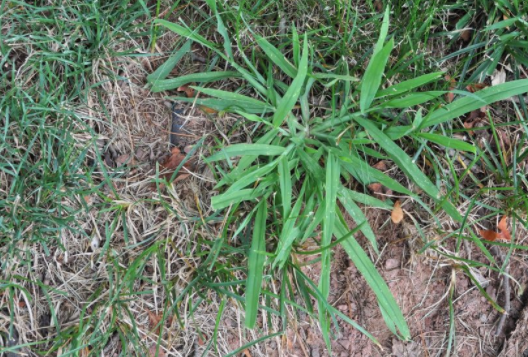Crabgrass is a warm-season annual plant that germinates, thrives and dies all in the same season. It remains to be one of the most difficult weeds to control in many lawns. So, when does crabgrass die?
Crabgrass dies in the fall as soon as it is hit by frost. As it dies, it leaves behind thousands of seeds that will germinate in the spring through late summer when the soil temperature hits above 55°F for at least 4 or more consecutive days.
When Does Crabgrass Die?
The first step in controlling crabgrass in a lawn is to understand its life cycle. Crabgrass reproduces by seeds, which germinate from spring through late summer when the soil temperature hits above 55°F for at least 4 or more consecutive days.
Crabgrass will continues to grow until midsummer when days become shorter. By this time, the vegetative growth of this weed slows and plants enter their reproductive stage.
It will then start forming and dropping seeds until it gets killed by the frost. Crabgrass seeds will remain dormant during the cold temperatures of winter until spring when the weather warms up.
Crabgrass is very adaptive to high temperatures and dry soil conditions which are usually unfavourable to most turf grasses. This makes the weed very competitive when the rest of your lawn is stressed.
For this reason, crabgrass will rapidly spread, and take up a lawn that is struggling.

Crabgrass Management Techniques
Effective control of crabgrass needs the deployment of both cultural and chemical approaches. The success of the process also requires several seasons of consistency in the management approach.
Proper lawn maintenance has been proven as a defence against crabgrass. Maintain a healthy lawn, fertilizing, deep watering and cutting grass higher naturally discourages the growth of crabgrass in your lawn.
Application of a pre-emergent herbicide in spring and post-emergent herbicide in summer can help in keeping crabgrass out of your lawn forever. Pre-emergent herbicides kill crabgrass weed before the seeds germinate fully.
Post-emergent herbicides on the other hand kill the already germinated and established weeds.
Post-Emergent Herbicide for Crabgrass Control
A post-emergent herbicide can help control the already germinated or established crabgrass seedlings. Early summer is the best time to apply a post-emergent crabgrass herbicide right when the weed has germinated. Directly apply your herbicides on the crabgrass plants on a calm, sunny day.
The application should be done in the morning when the temperatures are calm. If you are dealing with established crabgrass plants, reapplication of the herbicide needs to be done 5 to 10 days apart.
There is no need to apply a post-emergent in the fall as the plant has already dropped the seeds and waiting to die in frost.
Pre-Emergent Herbicide for Crabgrass Control
The pre-emergent herbicide will prevent crabgrass by killing the seedlings early in their growing stage, usually before the weed sprout out of the soil. These herbicides are also known as weed preventers.
Application is done directly on the soils. Most pre-emergent herbicides are usually not effective in temperatures above 90 degrees Fahrenheit.
The best time to apply crabgrass pre-emergent herbicide is from March to May and preferably when the soil temperatures have reached above 55°F for 4 or more consecutive days. The application can be done as early as January in warmer climates like California’s.
Sometimes it is difficult to determine the soil temperature without using a soil thermometer. You can watch other signs like weeds sprouting by your paved areas like driveways, sidewalks, or patios. You can also tell from the blooming bushes like Forsythia start blooming in your area.
NOTE: If you are creating a new lawn from seeds, or reseeding bare spots, crabgrass killer herbicides may harm your lawn seeds. Be sure to read the label instructions before using your herbicide. There is always a waiting time before you do the planting.
Final Thought
Controlling crabgrass in your lawn or garden can only be easy if you understand the weed’s growth cycle. You should know when it germinates, set seeds and also when it naturally dies. Good lawn care practices are known to prevent opportunistic crabgrass weeds.
References:
- University of Massachusetts Amherst: Biology and Management of Crabgrass
- University of Maryland Extension: Crabgrass Lifecycle, Habitat and Reproduction